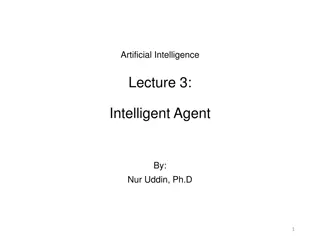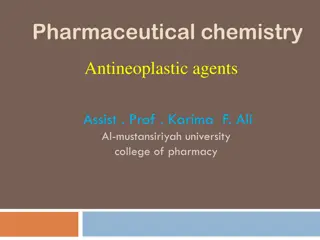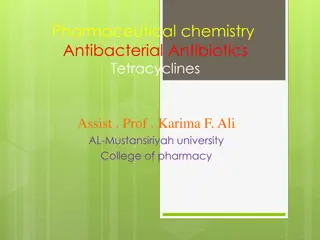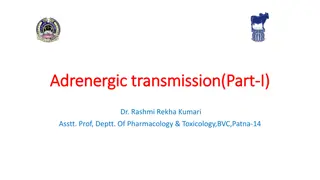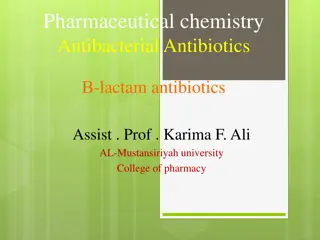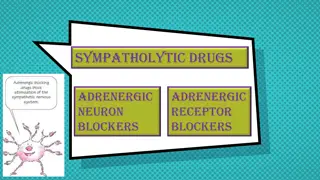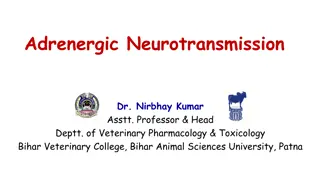Understanding Adrenergic Agents in Pharmaceutical Chemistry
Adrenergic agents play a crucial role in pharmacology by influencing the sympathetic nervous system through adrenergic receptors. These agents, such as sympathomimetics and sympatholytics, impact essential functions like cardiac activity, blood vessel dilation, and insulin release. Adrenergic neurotransmitters like noradrenaline and adrenaline are key players in this system. The physicochemical properties of catecholamines, oxidation susceptibility, and biosynthesis further shed light on their complex nature.
- Pharmaceutical Chemistry
- Adrenergic Agents
- Neurotransmitters
- Sympathetic Nervous System
- Catecholamines
Download Presentation

Please find below an Image/Link to download the presentation.
The content on the website is provided AS IS for your information and personal use only. It may not be sold, licensed, or shared on other websites without obtaining consent from the author. Download presentation by click this link. If you encounter any issues during the download, it is possible that the publisher has removed the file from their server.
E N D
Presentation Transcript
PHARMACEUTICAL CHEMISTRY Adrenergic Agents
Adrenergic drugs exert their principal pharmacological and therapeutic effects by either enhancing or reducing the activity of the various components of the sympathetic division of the autonomic nervous system. In general, substances that produce effects similar to stimulation of sympathetic nervous activity are known as sympathomimetics or adrenergic stimulants. Those that decrease sympathetic activity are referred to as sympatholytics, antiadrenergics, or adrenergic- blocking agents. Adrenergic agents act on Adrenergic receptors (Adrenoceptors,ARs) or affect the life cycle of Adrenergic neurotransmitters (NTs), including norepinephrine (NE, noradrenaline), epinephrine (E, adrenaline), and dopamine (DA).
Neurotransmitter involved in the adrenergic nervous system is noradrenaline. Adrenaline is a hormone which is released by the adrenal medulla at times of stress and activates adrenergic receptors. These NTs modulate many vital functions, such as: The rate and force of cardiac contraction, Constriction, and dilation of blood vessels and bronchioles, The release of insulin, The breakdown of fat.
Structure and Physicochemical Properties NE,E, and DA are chemically catecholamines (CAs) ,which refer generally to all organic compounds that contain a catechol nucleus (orthodihydroxybenzene) and an ethylamine group. In a physiological context, the term usually means DA and its metabolites NE and E. E contains one secondary amino group and three hydroxyl groups. E and NE each possess a chiral carbon atom; thus, each can exist as an enantiomeric pair of isomers. The enantiomer with the (R) configuration is biosynthesized by the body and possesses the biological activity. This (R) configuration of many other adrenergic agents also contributes to their high affinity to the corresponding adrenoceptors
Like most phenols, the catechol functional groups in CAs are highly susceptible to facile oxidation. E and NE undergo oxidation in the presence of oxygen (air) or other oxidizing agents to produce a quinone analog, which undergoes further reactions to give mixtures of colored products, one of which is adrenochrome .Hence, solutions of these drugs often are stabilized by the addition of an antioxidant (reducing agent) such as ascorbic acid or sodium bisulfite.
Biosynthesis The first step in CA biosynthesis is the 3-hydroxylation of the amino acid L-tyrosine to form L- dihydroxyphenyl alanine (L- DOPA) by tyrosine hydroxylase (TH, tyrosine-3- monooxygenase). As usual for the first enzyme in a biosynthetic pathway, TH hydroxylation is the rate-limiting step in the biosynthesis of NE. Further inhibitors of TH markedly reduce endogenous NE and DA in the brain and NE in the heart, spleen, and other sympathetically innervated tissues. This enzyme plays a key role in the regulation of CA biosynthesis and is, therefore, the logical biological target of some drugs.
The second step is the decarboxylation of L-DOPA to give DA. The enzyme involved is DOPA decarboxylase. The third step is side-chain hydroxylation of DA to give NE. The last step is the N-methylation of NE to give E in the adrenal medulla. The reaction is catalyzed by the enzyme phenylethanolamine-N-methyl (PNMT). transferase
Adrenergic Receptors Adrenergic Receptor Subtypes Most signaling molecules such as CAs are too polar to pass through the membrane, the information must be transmitted across the cell membrane without the molecules themselves entering the cell. An important factor in the response of any cell or organ to adrenergic drugs is the density and proportion of - and - adrenoceptors. For example, NE has relatively little capacity to increase bronchial airflow, because the receptors in bronchial smooth muscle are largely of the 2-subtype. In contrast, isoproterenol bronchodilators. (ISO) and E are potent
The clinical use of receptors-selective drugs becomes obvious when one considers the adrenoceptor subtypes and their locations. 1-Agonists as Vasoconstrictors and Nasal Decongestants. 1-Antagonists for Treatment of Hypertension. 2-Agonists for Treatment of Hypertension. 1-Blockers for Treatment of Hypertension, Angina, and Certain Cardiac Arrhythmias. 2-Agonists for Treatment of Asthma and Premature Labor.
-Adrenergic Receptors 1-receptors were designated as excitatory, while 2- receptors mediated inhibitory responses. The 1- and 2-receptors each divided into at least three subtypes. The -receptors are involved in control of the Cardio- vascular system. The 2-receptors not only play a role in the regulation of NE release but also regulate the release of other NTs, such as acetylcholine and serotonin. Both 1- and 2-receptors also play an important role in the regulation of several metabolic processes, such as insulin secretion and glycogenolysis.
-Adrenergic Receptors Three -receptor subtypes have been cloned, including 1, 2, and 3. The 2-receptors are located on smooth muscle throughout the body, where they are involved in relaxation of the smooth muscle, producing such effects as bronchodilation and vasodilatation The 3-receptor is located on brown adipose tissue and is involved in the stimulation of lipolysis.
Drugs Affecting Catecholamine Biosynthesis Metyrosine is a much more effective competitive production than agents that inhibit enzymes involved in CA biosynthesis. Metyrosine differs structurally from tyrosine only in the presence of an -methyl group. This unnatural amino acid is accepted by the enzymes of the biosynthetic pathway and converted to metaraminol (an -agonist). It is one example of a CA-biosynthesis inhibitor in clinical use. Inhibitors of Aromatic amino acid decarboxylase AADC (e.g., carbidopa) have proven to be clinically useful, but not as modulators of peripheral adrenergic transmission. Rather these agents are used to inhibit the metabolism of drug L-DOPA administered in the treatment of Parkinson disease inhibitor of E and NE
Metyrosine is used as a racemic mixture, which is given orally in dosages ranging from1 to 4 g/day, is used principally for the preoperative management of pheochromocytoma, chromaffin cell tumors that produce large amounts of NE and E. Although these adrenal medullary tumors are often benign, patients frequently suffer hypertensive episodes. Inhibitors of CA synthesis have limited clinical utility because such agents nonspecifically inhibit the formation of all CAs and result in many side effects. Sedation is the most common side effect of this drug.
Drugs Affecting Catecholamine Storage and Release 1.Reserpine (an NT Depleter). Reserpine, a prototypical and historically important drug, is an indole alkaloid obtained from the root of Rauwolfia serpentina found in India. It not only depletes the vesicle storage of NE in sympathetic neurons in PNS, neurons of the CNS, and E in the adrenal medulla, but also depletes the storage of serotonin and DA in their respective neurons in the brain.
2.Guanethidine (Ismelin) and guanadrel (Hylorel) Are used orally active antihypertensives. Drugs of this type enter the adrenergic neuron by way of the uptake-1 process and accumulate within the neuronal storage vesicles. They bind to the storage vesicles and stabilize the neuronal storage vesicle membranes, making them less responsive to nerve impulses.
Direct Acting Sympathomimetics The parent structure with the features in common for many of the adrenergic drugs is: -phenyl ethyl-amine. . The substitution on the meta-,and Para-positions of the aromatic ring, on the amino, and on - and -positions of the ethylamine side chain influences not only their mechanism of action, the receptor selectivity, but also their absorption, oral activity, metabolism, degradation, and thus duration of action .
Structureactivity relationships Important binding groups on catecholamines 1.Separation of Aromatic Ring and Amino Group. The greatest adrenergic activity occurs when two carbon atoms separate the aromatic ring from the amino group. This rule applies with few exceptions to all types of activities.
2. Substitution on the Amino Nitrogen Determines or - Receptor Selectivity Replacing nitrogen with carbon results in a large decline in activity. The activity is also affected by the number of substituents on the nitrogen.
Primary and secondary amines have good adrenergic activity, whereas tertiary amines and quaternary ammonium salts do not.
4. OH substitution on the -carbon (carbon-1). Generally decreases CNS activity largely because it lowers lipid solubility. However, such substitution greatly enhances agonist activity at both and -receptors.
5. Substitution on the Aromatic Ring. Maximal and -activity also depends on the presence of 3 and 4 OH groups. Tyramine, which lacks two OH groups, has no affinity for adrenoceptors, indicating the importance of the OH groups. Studies of adrenoceptor structure suggest that the OH groups on serine residues form H bonds with the catechol OH groups at positions 3 and 4, respectively. Replacement of the catechol function with the resorcinol structure gives a selective 2- agonist , (metaproterenol). Furthermore, because the resorcinol ring is not a substrate for COMT, -agonists that contain this ring structure tend to have better absorption characteristics and a longer DOA than their catechol-containing counterparts.
In another approach, replacement of the meta-OH of the catechol structure with a hydroxymethyl group gives agents, such as albuterol, which show selectivity to the 2-receptor. Because they are not catechols, these agents are not metabolized by COMT and thus show improved oral bioavailability and longer DOA.
The catechol moiety is more important for 2 -activity than for 1-activity. For example, removal of the p-OH group from E gives phenylephrine, which, in contrast to E, is selective for the 1- receptor.
6. CAs without OH Groups. Phenylethylamines that lack OH groups on the ring and the -OH group on the side chain act almost exclusively by causing the release of NE from sympathetic nerve terminals and thus results in a loss of direct Sympathomimetic activity. Because substitution of phenylethylamine structure makes the resultant compounds less lipophilic, unsubstituted or alkyl substituted compounds cross the BBB more readily and have more central activity. OH groups on the
Endogenous catecholamines The three naturally occurring catecholamines DA, NE, and E are used as therapeutic agents.
-DAstimulates the 1-receptors of the heart to increase cardiac output. -NE is a stimulant of 1-, 2-, and 1-adrenoceptors (notice that lacking the N-methyl group results in lacking 2- and 3- activity). It has limited clinical application caused by the nonselective nature of its activities. -E is a potent stimulant of all 1-, 2-, 1-, 2-, and 3- adrenoceptors,). It is much more widely used clinically than NE. -CAs are light sensitive and easily oxidized on exposure to air because of the catechol ring system. -All are polar and rapidly metabolized by both COMT and MAO, resulting in poor oral bioavailability and short DOA.
Dipivefrin (Propine, Dipivalyl Epinephrine). Dipivefrin is a prodrug of Epinephrine that is formed by the esterification of the catechol OH groups of Epinephrine with pivalic acid. Most of the advantages of this prodrug over stem Epinephrine from improved bioavailability.
To overcome several of the pharmacokinetic and pharmaceutical shortcomings of E as an ophthalmic agent, the prodrug approach has been successfully applied. The greatly increased lipophilicity allows much greater penetrability in to the eye through the corneal epithelial and endothelial layer. Dipivefrin has the 1-OH group and cationic Nitrogen. This dual solubility permits much greater penetrability into the eye than the very hydrophilic E hydrochloride. Increased DOA is also achieved because the drug is resistant to the metabolism by COMT. After its absorption, it is converted to E by esterases slowly in the cornea and anterior chamber. Dipivefrin also offers the advantage of being less irritating to the eye than E.
Adrenergic agents Important binding groups for adrenergic agents
Adrenergic agents -adrenergic receptor agonists All selective 1-agonists have therapeutic activity as vasoconstrictors. Structurally, they include: (a)Phenylethanolamine derivatives: such as phenylephrine, Metaraminol, and methoxamine. (b) 2-arylimidazolines derivatives: such as xylometazoline,oxymetazoline,tetrahydrozoline, and naphazoline.
Phenylephrine. (Neo- Synephrine), a prototypical selective direct-acting 1- agonist differs from E only in lacking a p-OH group. It is orally active, and its DOA is about twice that of E because it lacks the catechol moiety and thus is not metabolized by COMT. However, its oral bioavailability is less than 10% because of its hydrophilic properties , intestinal 3-O-glucuronidation/ sulfation and metabolism by MAO. Lacking the p-OH group, it is less potent than E and NE but it is a selective 1-agonist and thus a potent vasoconstrictor. It is used for hypotension. Metaraminol is just another example.
Methoxamine (Vasoxyl) Methoxamine (prodrug) is another 1-agonist and parenteral vasopressor used therapeutically and so have few cardiac stimulatory properties. It is bioactivated by O-demethylation to an active m-phenolic metabolite. It is less potent than phenylephrine as a vasoconstrictor. It does not stimulate the CNS. Because it is not a substrate for COMT, its DOA is significantly longer than NE.
Midodrine (ProAmatine) The N- glycyl prodrug of the selective 1-agonist desglymidodrine. Removal of the N-glycyl moiety from midodrine occurs readily in the liver as well as throughout the body, presumably by amidases. Midodrine is orally active and represents another example of a dimethoxy- -phenylethylamine derivative that is used therapeutically for its vasoconstrictor properties.
Methyldopa (L-methyldopa, Aldomet) Differs structurally from L-DOPA only in the presence of a - methyl group. Methyldopa ultimately decreases the concentration of DA, NE, E, and serotonin in the CNS and periphery. However, its mechanism of action is not caused by its inhibition of AADC(L- Aromatic Amino acid Decarboxylase) but, rather, by its metabolism in the CNS to its active metabolite ( -methyl norepinephrine). This active metabolite is a selective 2-agonist because it has correct (1R,2S) configuration
- methyl norepinephrine acts on 2-receptors in the CNS in the same manner as clonidine, to decrease sympathetic outflow and lower blood pressure. It is converted to methyldopa in the body through the action of esterases
Metabolic conversion of methyldopate and methyldopa to methyl norepinephrine






